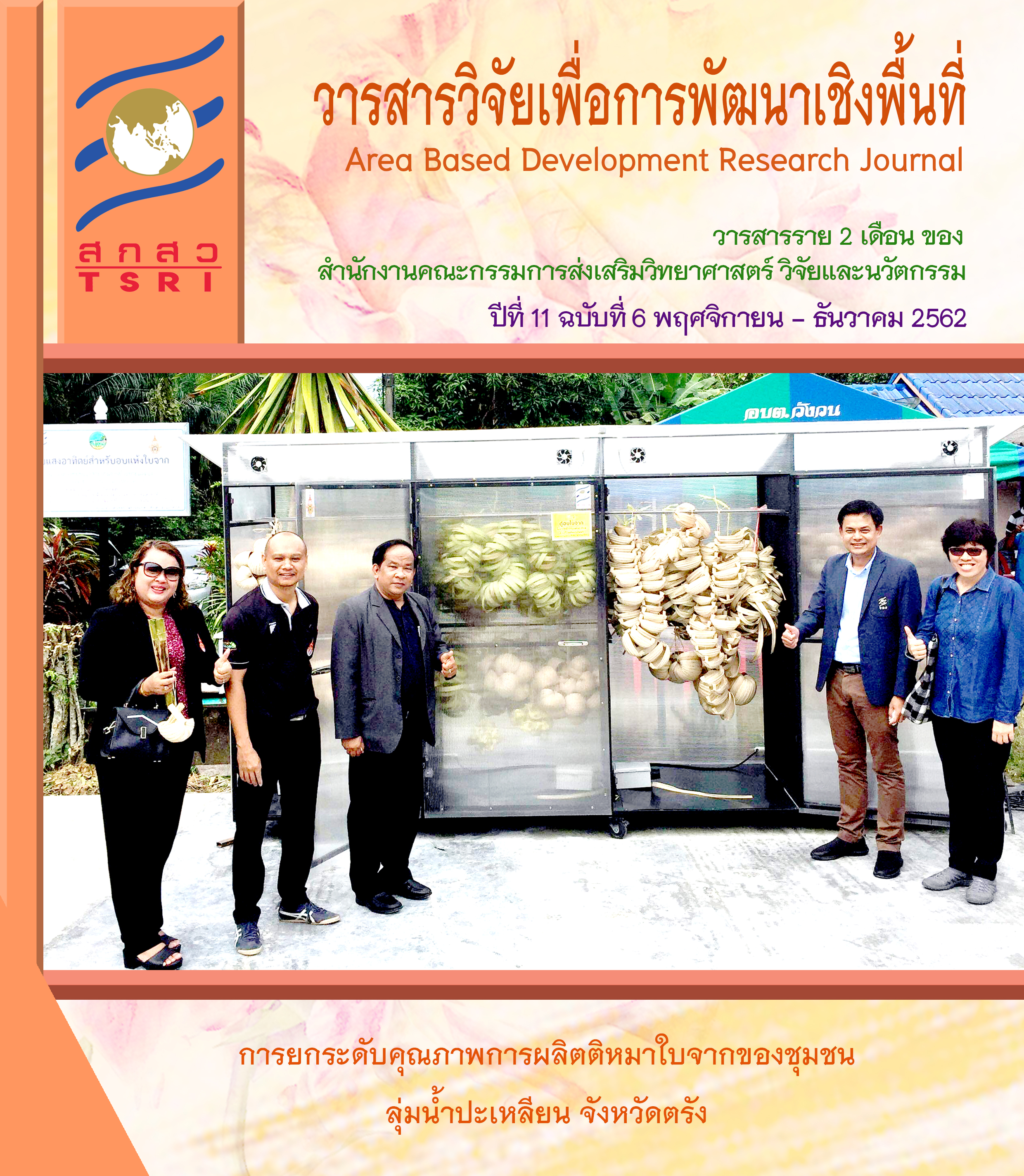Knowledge of Biological Science from Laboratories of Modification on PD.7 Fermentation Techniques for Removal of Mealy Bug, the Cause of Pineapple Wilt
Main Article Content
Abstract
The current study aims to extend and promote the body of science knowledge that benefits an area-based development by using a synthesized model from research process. The proposed case study is the processing development of a new fermentation technique of the PD.7 that produces multi-enzyme, used for removal of Mealy bug which is the cause of pineapple wilt. The obtained model can be described in several steps. The first step is to engage the farmer in the scientific experiment with the missions to observe, investigate and take note of the results by themselves. The farmers reveal the experiment results that the use of soybean meal as a raw material for fermentation can induce the microbes to create at least 3 types of enzymes; glycoside hydrolase, protease and lipase. The produced enzyme succeeds in removing the mealy bug at a “very good” level. Farmers have accepted the new bio-extract fermented formula, with as much as 75% of the farmers deciding to use it after having learned its potential. The second step is to promote the outcome to other farmers. This involves dialoguing and publishing the results in a wider community. The last step deals with knowledge management and technology transfer project. The key techniques for success in raising farmers’ awareness include: 1) the transfer of newly-acquired knowledge from laboratory, 2) the availability of raw materials at a later stage for farmer’s demonstrations afterwards, and 3) the opportunity for knowledge sharing by visiting nearby farms. These techniques help empower the farmers to act and build upon their own activities.
Article Details

This work is licensed under a Creative Commons Attribution-NonCommercial-NoDerivatives 4.0 International License.
Area Based Development Research Journal values copyright protection and licensing to safeguard author rights and facilitate the appropriate dissemination of research. Our policies ensure openness, accessibility, and attribution. Authors retain copyright ownership, and articles are published under a Creative Commons Attribution License (CC BY), allowing sharing, adaptation, and proper attribution. Authors have the freedom to publish under the CC BY license, granting broad reuse and distribution permissions. The journal supports posting articles on third-party repositories, adhering to institutional and funding restrictions. Author guidelines detail copyright and licensing requirements, empowering authors with knowledge about their rights and responsibilities. These policies cultivate an environment of collaboration, openness, and responsible sharing, benefiting authors and the research community while honoring intellectual property rights.
References
ชาญณรงค์ ดวงสะอาด. (2552). พื้นฐานของการควบคุมแมลงศัตรูพืชโดยชีววิธี. เชียงใหม่: โรงพิมพ์ดีพริ้นท์.
ณฐพงศ์ เมธินธรังสรรค์. (2560). ผลจากสารสกัดจากใบสาบเสือในการควบคุมเพลี้ยอ่อนถั่ว Aphis craccivora Koch (Hemiptera: Aphididae). วารสารวิทยาศาสตร์และเทคโนโลยี มหาวิทยาลัยมหาสารคาม, 37(1), 79-84.
ธนวรรณ สงประเสริฐ, อุไร จเรประพาฬ, สามารถ สุวรรณภักดี และ กำไล สมรักษ์. (2562). รูปแบบการดำเนินงานของชุมชน
เพื่อลดการใช้สารเคมีทางการเกษตร ชุมชนบ้านพิตำ จังหวัดนครศรีธรรมราช. วารสารวิจัยเพื่อการพัฒนาเชิงพื้นที่, 11(1), 47-61.
พันธ์ทวี สหะรัตน์. (2554). สมุนไพร:เพลี้ยแป้งมันสำปะหลัง. สืบค้นเมื่อ 1 ธันวาคม 2560, จากhttps://www.kpcat.ac.th/PR/Research/Research03.pdf
มัลลิกา นวลแก้ว. (2556). รายงานสำนักวิจัยและพัฒนาการเกษตรเขตที่ 5. กรุงเทพ ฯ: กระทรวงเกษตรและสหกรณ์.
วันเพ็ญ ศรีทองชัย, ปริเชษฐ์ ตั้งกาญจนภาสน์ และกาญจนา วาระวิชะนี. (2554). ความสัมพันธ์ระหว่างชนิดของไวรัส
Pineapple mealybug wilt-associated virus and mealybug species in causing pineapple wilt disease. (รายงานวิจัย). กรุงเทพ ฯ: สำนักวิจัยพัฒนาการอารักขาพืช กรมวิชาการเกษตร.
ศูนย์ประสานงานโครงการอันเนื่องมาจากพระราชดำริ ศูนย์ประเมินผล สำนักงานเศรษฐกิจการเกษตร. (2555). ผลการวิจัยประเมินองค์
ความรู้ของปราชญ์เกษตรของแผ่นดินสาขาปราชญ์เกษตรเศรษฐกิจพอเพียง ปี 2552-2555. สืบค้นเมื่อ 1 ธันวาคม 2560, จาก https://drive.google.com/file/d/0BzGmrcntzVbkeW5tS2Z5NElRRFU/view
Adang, M. J. (2004). Insect Amino Peptidase N. In Barrett, A., Rawlings, N. & Woessner, J, Handbook of Proteolytic Enzymes (pp.296–299). Elsevier B.V., Netherlands: Academic Press.
Bali, N.S., Remadevi, O.K., Sasidharan, T.O., Balachander, M. and Dharmarajan, P. (2012). Cuticle degrading
enzyme production by some isolates of the Entomopathogenic fungus, Metarhizium Anisopliae
(METSCH). Journal of Bio-Science, 20, 25-32.
Dassanayake, E.M. and Perera, W.G.S. (2001). Effect of heat therapy to control pineapple wilt virus in
pineapple (Ananus comosus). Vidyodaya Journal of Science, 10, 135-150.
Gunasinghe, U.B. and German, T.L. (1989). Purification and partial characterization of a virus from
pineapple. Etiology, 79, 1337-1341.
Leger, R.J.St., Charnley, A.K. and Cooper, R.M. (1986). Cuticle degrading enzymes of Entomopathagenic
fungi: mechanisms of interaction between pathogen enzymes and insect cuticle. Journal of
Invertebrate Pathology, 47, 295-302.
Priyanka, D. and Gurvinder, K. (2010). Production of cuticle degrading protease by Beauveria bassiana and
their induction in different media. African Journal of Biochemistry Research, 4(3), 65-72.
Shaukat, A., Zhen, H. and Shunxiang, R. (2010). Production of cuticle degrading enzymes by Isaria
Fumosorosea and their evaluation as a Biocontrol agent against diamondback moth. Journal of
Pest Science, 83, 361-370.


